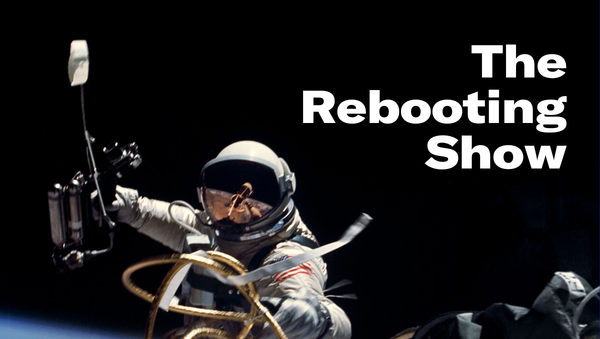The Daily Upside's growth playbook
The finance newsletter has grown to 850,000 subscribers in four years

Hope everyone’s week is off to a good start. On this week’s episode of The Rebooting Show, I spoke to Patrick Trousdale, the founder of The Daily Upside, about how he grew the daily business news newsletter to 850,000 subscribers. Also, the week in AI insanity and recommendations. Send me your feedback to bmorrissey@therebooting.com.

The Daily Upside’s growth playbook
The outstanding question of the newsletter mini-boom is whether it will create a new class of durable publishing brands. Morning Brew is the pace setter, of course. Newsletters are like any field with a bell curve of a small number who achieve escape velocity and a mass of the rest. The Daily Upside is a newsletter I think has a shot at breaking out and becoming a durable brand.
Patrick Trousdale started The Daily Upside in 2019 after working in investment banking at Guggenheim. Patrick saw the success Morning Brew and The Hustle had with newsletters that produced business, finance and entrepreneurial news for younger audiences. He started The Daily Upside with the idea there was space for a newsletter that catered more to investors as a lens instead of general business and finance.
Like many newsletters, Patrick found a distribution “hack.” (I don’t mean this pejoratively; finding unique distribution advantages has always been critical in the media business.) He struck a partnership with The Motley Fool, which acquired a stake in The Daily Upside, and marketed the newsletter to The Motley Fool’s massive audience. Simon Owens has good background on this in his conversation with Patrick from last May.) Newsletter growth is never easy – nothing is, at least in media – but it gets easier to grow as your base gets larger. To put that in perspective, last May The Daily Upside was at 300,000 subscribers, and it now sits at 850,000.
Beyond The Motley Fool, The Daily Upside’s growth playbook leans on acquiring subscribers through so-called newsletter swaps (basically barter ad deals with other newsletters that have overlapping but distinct audiences), TikTok and YouTube creator deals, and of course regular ads on platforms like Facebook.
The Daily Upside is now at the point where it can incrementally expand. It started that in January with the acquisition of a specialist newsletter called Patent Drop that trawls patent registries for updates on what tech companies are filing patents that will expand into a publication focused on “technologies like blockchain and AI, how policy is impacting tech innovation, and conversations with the thought leaders and entrepreneurs building the future.” The Daily Upside will also launch Power Corridor, a publication at the intersection of Wall Street and Washington with longtime Institutional Investor journalist Leah Goodman.
The opportunity Patrick sees is applying The Daily Upside growth playbook to these new properties – and using them to move beyond aggregation. Making the shift from aggregation to original content is a time-honored and tricky path in digital publishing. I can remember when Business Insider was mostly aggregating the reporting of others.
One note: I’ve been in Miami for a week, and somehow forgot my microphone, so I had to do this one with my AirPods. Thanks to Jay Sparks, my producer, for making the audio sound good. BTW, if you’re interested in a podcast of your own, get in touch with Jay.

Glide makes a cloud-based publishing platform used by leading publishers like News UK. Glide CEO Denis Haman explains the common mistakes publishers make with their content management systems:
“The most obvious mistake is trying to build one themselves, either from scratch or on top of open source or a starter generic CMS. When that happens, you’ve become a CMS business. Should you build your own CRM or Email or HR systems? Of course not. But many get pulled into making CMS. Spoiler alert from someone who’s been doing it for nearly 30 years - very few publishers need to do it themselves now. The notion of “free software” gets sold into leadership without revealing that it needs however many staff full-time to make it usable and supportable for its lifespan. Yeah, that’s not ‘free’, and you are now tied in for its existence.”
Learn how Glide helps publishers win with a lean media approach.

AI week in review
The famous New Yorker cartoon in 1993 showed a dog at a computer explaining to another dog “Nobody on the internet knows you’re a dog.” Turned out to be prophetic. I continue to go down the AI rabbit hole, and I’m increasingly confident that these developments will have profound effects on on many areas of life, some good and some bad. I mean, Henry Kissinger at 99 is writing op-eds in the WSJ calling AI a development on par with the Enlightenment.
The next few years will be chaotic, as AI is applied to anything and everything, and a parade of startups and Web3 charlatans look to pile in on the action. Most will be duds, but the technology will continue to advance. There will be the weird, like efforts to construct AI gods. The real action will be as the giant tech platforms battle for power. Microsoft wants to make Google dance, and Facebook (just change the name back already) is already talking up AI (and not so much the metaverse) and coming out with its ChatGPT-like service.
There is little stopping it. Tucker Carlson might not want AI-powered autonomous driving to replace truck drivers, weirdly finding himself on the other side of Ben Shapiro, but if it doesn’t, that will be a political decision. AI isn’t a natural fit for the right-left divide of politics. The efforts to cast it as “woke AI” will fail. There will be right wing chatbots, don’t worry, just train it on Fox News. History tells us that technology advancements displace jobs, then creates other ones. “Prompt engineers” hold the promise of being an engineer without the science part. Seems fair since AI makes people “artists” without having to grind through the artistic process, as Kyle Chayka notes.
My concern is the impact it will have on trust overall. This has been a bad run for trust in institutions, from the government to media and beyond. Algorithms have accelerated society’s shifts into factions and tribes. I can’t see how having an autocomplete robot parroting our biases will improve that. AI filters on TikTok are already terrifying, and it’s hard to see how that will improve teen anxiety. Same goes for Snapchat’s new AI friend at a time of rising loneliness and depression among teens.
With AI pointed at nearly everything, it’s best to focus on where the money is to determine its most immediate impact. Ezra Klein makes a compelling argument that AI bots will be deployed heavily in advertising. The dream of 1:1 persuasion doesn’t get much better (and scalable) than a persuasive robot who sounds like a human, even if it’s just auto-completing sentences. Depending on your point of view this is either a crisis of late-stage capitalism or a new business line for Bain.
The hand-wringing of the “creative” classes will continue. AI is shining a light on how easy it is to automate away many white-collar jobs the same way blue collar jobs were lost to automation and outsourcing. The sudden discovery of this as perhaps a worrying development is… convenient.
We’re still in the denial phase overall: “Writing is and should be hard – a lonely walk in the dark with the facts, your ideas and your facility with language. The robots will need to get a lot more neurotic if they ever hope to become true writers,” Brad Stone notes. But it will also enable new forms of creativity, even silly “deep fakes” like the gaming presidents, which I find somewhat touching because it would be nice if Biden, Trump and Obama had a friendly group text.

Hashtag Labs is a full-service digital ad operations company, offering software and services that help publishers achieve their advertising-related revenue goals. I asked Hashtag Labs CEO John Shankman for what he sees as the biggest trend in ad tech not enough people are talking about.
“Simplification and standardization on the supply-side of advertising technology. A lot of the discussion around supply-path optimization on the buy-side is about better understanding how to access quality inventory at the best rates possible — why is this a topic? It's because the digital supply chain has become increasingly complex since its advent and there's no real unified way to understand the ad requests coming from publisher pages at the advertiser DSP. Similarly, publishers need controls for pricing and allowing advertisers to access premium inventory. Be on the lookout for protocols and methods to emerge that facilitate the supply-side providing a more standard way to define data included in ad requests and getting that information to advertisers via the most direct path possible. This should result in a win-win effort for both quality advertisers and publishers that yields higher rates and performance.”

Recommendations
Ezra Klein had an interesting conversation with Tim Hwang about his new book, “Subprime Attention Crisis,” which trains its sights on how the internet financialized attention – and created perverse rewards along the way.
Many U.S. publications have reeled in their international expansion plans, but Axel Springer-owned Politico now has 30-odd journalists inits London outpost.
The Year of Efficiency could turn into an Efficiency Era. Publishers face many challenges, and they will need to get leaner. Hearst moving to category sales is an inevitability – and a further sign that the day of individual publishing brands being sacrosanct is long past.
GroupM, the largest ad buyer in the world, has linked up with Internews to find a middle ground between the demand from advertisers for “brand safety” and the reality that high-quality, reliable news shouldn’t be a luxury good only available to those with the means to pay for subscriptions.

Thanks for reading. Send me a note with your feedback: bmorrissey@therebooting.com. You can also just hit reply to the email.
If you’re looking to reach 14,200 publishing professionals, you should consider sponsoring The Rebooting to showcase your expertise in finding paths forward for building sustainable media businesses. Check out the sales kit and get in touch.




